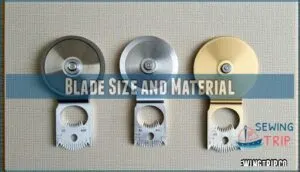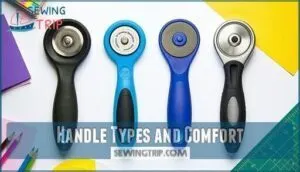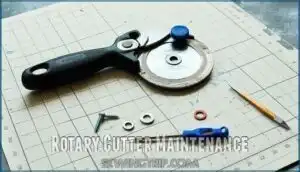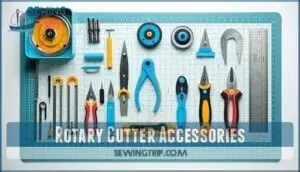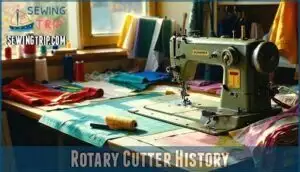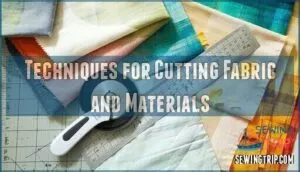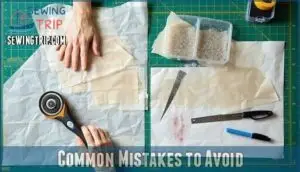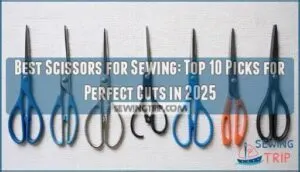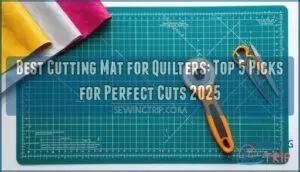This site is supported by our readers. We may earn a commission, at no cost to you, if you purchase through links.
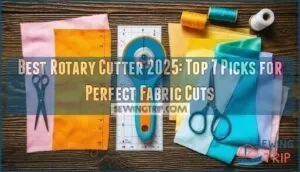
You’ll want to take into account blade size first—45mm handles most projects while 60mm powers through thick layers like butter.
The Fiskars 45mm leads our top picks with its reliable safety lock and comfortable grip that won’t cramp your hand during marathon cutting sessions.
For lefties, the Martelli Ergonomic is a game-changer.
Don’t overlook budget options like the NICAPA set—sometimes the underdog surprises you.
Electric models are worth considering if you’re cutting multiple layers regularly.
Your choice depends on project types, hand size, and how often you’ll use it.
Table Of Contents
Key Takeaways
- You’ll want to prioritize blade size when choosing – 45mm handles most projects perfectly while 60mm powers through thick layers, and titanium-coated blades last three times longer than standard steel ones.
- Ergonomic handles are game-changers for your comfort – look for curved grips and ambidextrous designs that reduce wrist strain by up to 40% during marathon cutting sessions.
- Safety features aren’t optional – retractable blades, sliding locks, and blade guards protect your fingers while proper storage keeps everyone safe around these razor-sharp tools.
- You’ll get better results with the right accessories – pair your cutter with a self-healing cutting mat, clear acrylic rulers, and keep replacement blades handy for consistently clean cuts.
Best Rotary Cutter
Finding the perfect rotary cutter can feel like searching for that one missing puzzle piece – you know it exists, but where exactly?
You’ll want to take into account blade size, handle comfort, and safety features when choosing from these seven top-rated cutters that’ll make your fabric cutting smoother than your morning coffee routine.
The goal is to find a cutter that makes your fabric cutting smoother than your morning coffee routine, which is why considering these factors is crucial.
1. Fiskars 45mm Rotary Fabric Cutter
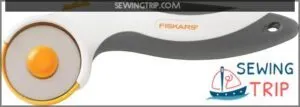
The Fiskars 45mm Rotary Fabric Cutter is your cutting companion that won’t quit.
Its titanium-coated blade stays sharp three times longer than steel, slicing through multiple fabric layers like butter.
You’ll love the symmetrical handle that fits both righties and lefties perfectly.
The sliding button keeps things safe – extend, lock, and retract with ease.
At around $21, it’s a steal for quilters and crafters.
Plus, Fiskars backs it with a lifetime warranty.
This tool transforms tedious cutting into smooth, precise work you’ll actually enjoy.
However, some users find that Olfa blades are sharper.
Best For: Crafters, quilters, and sewing enthusiasts who need a reliable, durable rotary cutter for precise fabric cutting.
- Titanium-coated blade lasts three times longer than steel.
- Ergonomically designed handle works for both right- and left-handed users.
- Offers safe storage with a retractable blade mechanism.
- Blade replacement is not covered under the lifetime warranty.
- Limited to cutting 2-3 fabric layers at a time for best results.
- Some users report Olfa blades are sharper for comparison.
2. Martelli Right Handed Ergonomic Rotary Cutter
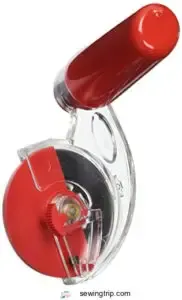
Your wrists will thank you after trying the Martelli Right Handed Ergonomic Rotary Cutter.
This game-changer features a patented doughroller design that lets you push forward naturally, cutting your wrist strain by 40%.
The tungsten steel blade stays sharp 3-5 times longer than standard cutters, slicing through 6-8 fabric layers like butter.
Spring-loaded guards keep everyone safe while the red grip fits perfectly in right hands.
It’s pricier than basic models, but your comfort during marathon quilting sessions makes it worthwhile.
Best For: Professional and hobbyist quilters seeking ergonomic, durable, and precise cutting tools for extended crafting sessions.
- Ergonomic design reduces wrist strain by 40% during use.
- Tungsten steel blade cuts 6-8 fabric layers and lasts 3-5 times longer than standard blades.
- Spring-loaded blade guards enhance safety and blade longevity.
- More expensive than basic rotary cutters.
- Not suitable for left-handed users (requires the left-handed version).
- Large 60mm blade may not be ideal for intricate cutting tasks.
3. NICAPA 45mm Rotary Fabric Cutter Set
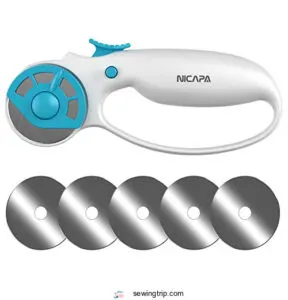
With its distinctive blue design and professional-grade construction, the NICAPA 45mm Rotary Fabric Cutter Set delivers impressive cutting performance without breaking the bank.
You’ll appreciate the ergonomic grip that reduces hand strain during marathon quilting sessions, while the precision-engineered blade maintains sharpness through countless projects.
The extensive set includes handy accessories that boost your crafting versatility, and its lightweight design gives you excellent maneuverability.
The protective blade cover keeps everyone safe, and it’s a solid choice for both weekend warriors and serious crafters.
Best For: Crafted for quilting enthusiasts, sewing professionals, and hobbyists seeking precision and reduced hand fatigue.
- Blade size may limit suitability for large-scale cutting tasks.
- Requires careful handling to avoid accidental cuts despite safety features.
- Limited to specific material types like fabric, paper, felt, and vinyl.
- Ergonomic grip minimizes hand and joint strain during extended use.
- Sharp, precision-engineered blade delivers consistent and accurate cuts.
- Includes 5 extra replacement blades for long-lasting value.
4. OLFA RTY-2/G Rotary Cutter
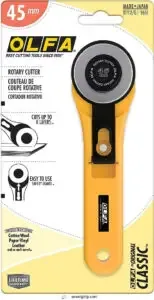
Precision meets heritage with OLFA’s RTY-2/G, the world’s first rotary cutter since 1979.
You’ll love its reversible tungsten blade that stays sharp longer than standard steel options.
The straight handle design feels natural in both hands, making it perfect for extended cutting sessions.
At around $22, it’s budget-friendly without sacrificing quality.
Users consistently praise its superior sharpness compared to bulkier competitors.
This lightweight cutter produces incredibly clean cuts with minimal effort, making it ideal for detailed quilting work and precise fabric trimming tasks.
Best For: Quilters, crafters, and fabric enthusiasts who need a precise, sharp, and easy-to-use rotary cutter for detailed cutting work.
- Smaller blade may require careful handling.
- Straight handle preference may vary by user.
- Does not include additional blades in the base package.
- Reversible tungsten blade stays sharp longer.
- Comfortable straight handle design for both hands.
- Produces clean, effortless cuts for precision.
5. Electric Fabric Rotary Cutter Scissors
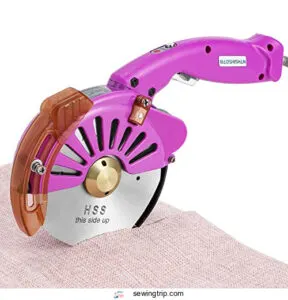
Revolutionizing fabric cutting, electric rotary scissors bring power to your fingertips.
You’ll slice through 10-20 layers of fabric in one smooth pass, handling everything from delicate silk to thick carpet.
The built-in LED light keeps your cutting line visible, while five adjustable speed gears let you match the pace to your project.
With three smooth rollers and an ergonomic design, these scissors turn marathon cutting sessions into quick sprints.
The built-in sharpening stone means you’re always ready for the next creative challenge, and the ability to handle materials like delicate silk to thick carpet showcases their versatility.
Best For: Hobbyists and professional sewers needing efficient and precise cutting for various fabric types and thicknesses.
- Cuts through 10-20 layers of fabric in a single pass.
- LED light enhances visibility for precision in low-light conditions.
- Built-in sharpening stone ensures consistently sharp blades.
- May require practice to master speed and blade adjustments.
- Not ideal for fabrics exceeding 27mm thickness.
- Battery-powered models might need frequent recharging for long sessions.
6. Fiskars Contour Rotary Cutter 45mm
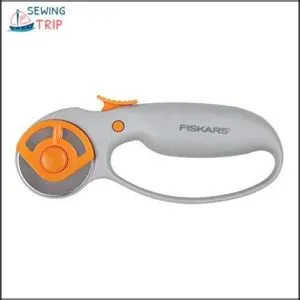
When cutting through thick fabric stacks feels like wrestling with butter, the Fiskars Contour Rotary Cutter 45mm swoops in as your ergonomic hero.
Its curved handle cradles your hand naturally, reducing strain during marathon quilting sessions.
The precision-ground stainless steel blade slices cleanly through multiple layers while the safety lock keeps fingers protected.
You’ll appreciate the ambidextrous design and pushbutton blade withdrawal feature.
Though some users need extra pressure for clean cuts, this lightweight cutter delivers consistent performance for detailed patchwork and general fabric cutting tasks.
Best For: Quilters, crafters, and textile workers looking for ergonomic ease and precision in fabric cutting.
- Requires extra pressure for clean cuts on some materials.
- Screw may loosen with repeated use over time.
- Not suitable for cutting thick materials like foam core or cardboard.
- Ergonomic handle reduces hand and wrist strain during use.
- Super sharp stainless steel blade allows clean cuts through multiple fabric layers.
- Ambidextrous design supports both right- and left-handed users.
7. Fiskars Titanium Softgrip Rotary Cutter
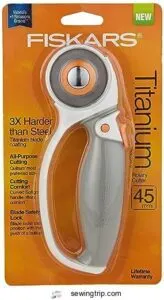
When titanium meets fabric cutting, magic happens.
The Fiskars Titanium Softgrip rotary cutter features a blade that’s three times harder than steel, giving you razor-sharp precision that lasts.
Its ergonomic loop handle fits naturally in your hand, reducing wrist strain during marathon quilting sessions.
You’ll slice through multiple fabric layers like butter, while the retractable blade keeps things safe.
At just 1.6 ounces, it won’t tire you out.
Perfect for quilters who demand professional results without the professional price tag.
Best For: Quilters, crafters, and sewing enthusiasts looking for precision and comfort in cutting multiple fabric layers or materials.
- Durable, titanium-coated blade stays sharp and cuts through fabrics effortlessly.
- Ergonomic Softgrip handle minimizes wrist strain and enhances control.
- Lightweight and ambidextrous design suitable for extended use.
- Limited cutting depth may not handle very thick materials.
- First-time users may need slight adjustment to understand blade retraction.
- Replacement blades may add to long-term costs.
Rotary Cutter Basics
You’ve probably struggled with scissors that create jagged edges or slip on slippery fabrics like silk – that’s where rotary cutters come to the rescue with their pizza-cutter-like design that delivers razor-sharp, precise cuts every time.
These handy tools feature a rotating blade attached to an ergonomic handle, letting you slice through multiple fabric layers effortlessly while built-in safety guards keep your fingers protected from those incredibly sharp edges.
Clean Cuts and Precision
Now that you’ve seen the top picks, let’s talk about what makes a rotary cutter truly shine.
When your blade sharpness is on point, you’ll notice the difference immediately. Sharp rotary cutter blades glide through fabric like butter, creating consistent lines that scissors simply can’t match.
Cutting precision becomes second nature when you master pressure control and cutting angles.
- Say goodbye to frayed edges – Your fabric stability improves dramatically with clean, precise cuts
- Feel the satisfaction – Cutting accuracy transforms tedious tasks into enjoyable crafting sessions
- Experience the confidence – Consistent lines mean your projects look professionally finished every time
Ergonomic Designs and Safety Features
Modern rotary cutters prioritize your comfort with ergonomic handles that reduce hand fatigue during extended cutting sessions.
You’ll find essential safety features like blade retraction buttons and safety locks that prevent accidental cuts.
Comfort grips accommodate both left and right-handed users, while ambidextrous design guarantees everyone can cut safely.
These safety guards make your crafting experience worry-free.
Choosing Right Rotary Cutter
You’ll want to keep in mind three main factors when picking your rotary cutter: blade size (45mm works great for most projects, while 28mm handles tight curves and 60mm tackles thick layers), handle comfort (ergonomic grips save your wrist during marathon cutting sessions), and safety features like retractable guards that’ll keep your fingers intact.
Think of it like choosing the right knife for cooking – the wrong tool makes everything harder, but the perfect match turns cutting fabric into a smooth, satisfying experience, with smooth experience being the ultimate goal.
Blade Size and Material
You’ll find that blade size and material substantially impact your cutting experience.
The right combination determines blade durability and cutting precision across multiple fabric layers.
Consider these key factors when selecting rotary cutter blades:
- 45mm blades offer the perfect balance for general use and most fabric types
- Titanium blade materials provide superior material strength and extended blade lifespan
- 60mm options excel at cutting thick fabric layers with enhanced precision.
For purchasing, consider a durable rotary cutter.
Handle Types and Comfort
A comfortable handle can make or break your cutting experience.
Ergonomic grips reduce hand fatigue during long projects, while lightweight handle materials prevent wrist strain.
Look for ambidextrous handles if you’re left-handed – they’re game-changers for comfort grip and fatigue reduction.
Many users find that a replacement can improve rotary cutter control.
| Handle Type | Material | Comfort Level | Best For |
|---|---|---|---|
| Contoured Grip | Soft Rubber | Excellent | Extended Use |
| Straight Handle | Hard Plastic | Good | Quick Tasks |
| Cushioned Grip | Foam Padding | Superior | Arthritis Relief |
| Weighted Handle | Metal Core | Moderate | Heavy Fabrics |
Safety Features and Locks
Look out for rotary cutter safety features that’ll keep your fingers intact during those marathon cutting sessions.
Blade retraction buttons and safety locks prevent accidental exposure, while trigger grips give you better control.
Child safety mechanisms are essential if little ones are around.
Quality blade guards and lock mechanisms aren’t just nice-to-haves—they’re your best defense against injury prevention mishaps.
Rotary Cutter Maintenance
Your rotary cutter’s going to last way longer if you take care of it properly, and trust me, it’s easier than you think.
Just like your car needs regular tune-ups, your cutter needs blade changes, occasional sharpening, and proper storage to keep delivering those crisp, clean cuts you love.
Sharpening Blades for Longevity
You can extend your blade’s life through proper sharpening.
Use a rotary blade sharpener with rough and fine sides, spinning the blade about 20 times per side.
Steel blades need more frequent sharpening than titanium ones.
Avoid cutting paper or pins as preventative measures.
When blade sharpness noticeably decreases, consider professional sharpening services for ideal rotary cutter maintenance.
Changing Blades for Optimal Performance
When your rotary cutter blades start catching fabric or leaving fuzzy edges, it’s time for blade replacement. Different blade types have varying lifespans – titanium lasts longer than steel.
Change blades before starting new projects to maintain peak performance impact. Safely dispose of dull blade signs by wrapping in cardboard.
Fresh rotary cutter blades dramatically improve cutting precision and reduce hand fatigue during extended crafting sessions.
Cleaning and Storage for Durability
After changing blades, proper cleaning keeps your rotary cutter performing like new.
Wipe the blade and handle with a damp cloth to remove fabric fibers and dust.
Store your cutter in a dry place with the blade retracted to prevent rust and accidents.
Clean your cutting mat regularly too – it’ll extend both the mat’s life and your blade’s sharpness.
Top Rotary Cutter Features
When you’re shopping for a rotary cutter, you’ll want to focus on three game-changing features that separate the best tools from the rest.
Look for durable titanium or steel blades that stay sharp longer, ergonomic handles that won’t cramp your hand during marathon cutting sessions.
And reliable safety locks that keep those razor-sharp blades tucked away when you’re not using them.
Durability and Longevity
Want your rotary cutter to last years instead of months? Quality blade materials and solid handle construction make all the difference.
Smart storage methods and proper usage frequency prevent premature blade dulling, saving you money on rotary cutter replacement costs. The right choice depends on rotary cutter sizes.
- Premium blade materials like titanium-coated steel resist wear longer than standard options
- Rust prevention through dry storage extends blade life substantially
- Regular blade maintenance beats frequent blade replacement every time
- Proper storage methods protect both blades and handles from damage
Ergonomic Handles and Comfort
A comfortable ergonomic rotary cutter makes all the difference during long cutting sessions.
Look for curved handle design and comfort grip features that fit your hand naturally.
The best handle materials reduce hand fatigue while ambidextrous design accommodates both lefties and righties.
User feedback consistently shows that fatigue reduction comes from grip types that support your natural hand position perfectly.
Safety Latches and Guards
Beyond comfort lies protection – your fingertips deserve better than unexpected nicks.
Modern rotary cutters pack serious safety features that’ll keep you cutting worry-free through late-night quilting sessions.
Smart safety locks prevent accidental exposure while you’re focused on perfect seams:
- Blade retraction systems automatically hide blades when released
- Dual-action locks require deliberate moves to activate cutting
- Trigger mechanisms keep blades secure during fabric manipulation
- Child safety features protect curious hands from sharp edges.
For worry-free storage, consider a cutter with a dedicated safety button.
Rotary Cutter Accessories
You’ll need the right accessories to get the most out of your rotary cutter – think of them as your cutting crew that makes every project smoother and safer.
A good cutting mat protects your blade and work surface, while rulers keep your cuts straight and replacement blades guarantee you’re always working with a sharp edge.
Cutting Mats for Protection
A quality rotary cutter mat transforms your cutting experience from frustrating to fantastic.
Self-healing benefits mean your cutting mat won’t show permanent scars after countless projects.
These mats protect your work surface while extending blade life substantially.
Understanding your target audience needs can help you choose the best mat for your projects.
| Feature | Small (12×18") | Medium (18×24") | Large (24×36") |
|---|---|---|---|
| Best For | Detail work | General quilting | Large projects |
| Storage | Easy portability | Moderate space | Dedicated area |
| Grid Markings | 1" increments | 1" with angles | Full grid system |
| Material | Self-healing PVC | Professional grade | Commercial quality |
| Lifespan | 2-3 years | 3-5 years | 5+ years |
Mat size considerations depend on your typical project scale.
Grid markings importance can’t be overstated—they’re your measuring guides.
Material composition impact affects durability and cutting performance.
Storage and lifespan vary with quality and usage frequency.
Rulers for Accuracy and Precision
Once you’ve got your mat sorted, quilting rulers become your best friend for perfect cuts.
These acrylic ruler gems from Omnigrid and Creative Grids feature non-slip features that won’t budge during cutting.
Look for beveled edges that protect your fingers and ruler stability through measurement systems you can trust.
Clear ruler materials let you see fabric placement perfectly, which is a key aspect of using quilting rulers.
Replacement Blades for Convenience
While rulers keep your cuts straight, you’ll need fresh blades to maintain that precision. Think of replacement blades as your rotary cutter’s lifeline – they’re what keep everything running smoothly.
Here’s your blade replacement game plan:
- Blade Material matters – titanium-coated options last longer than standard steel
- Changing Frequency should happen every 3-6 months with regular use
- Blade Storage in magnetic holders prevents accidents and maintains sharpness
- Blade Disposal requires taping old blades in folded cards for safety
For beginners, Fiskars blades last longer offering more durability.
Rotary Cutter History
You might be surprised to learn that rotary cutters started in garment factories before becoming the quilter’s best friend in the 1980s.
Before these wheeled wonders showed up, you’d spend hours with scissors trying to cut perfect fabric pieces, but rotary cutters changed everything by letting you slice through multiple layers with clean, straight cuts in seconds.
Evolution in Quilting and Crafting
You’ve probably wondered how quilters managed before rotary cutters came along.
Back in 1979, Olfa introduced the first rotary cutter as a scissors alternative, sparking a quilting revolution.
This design evolution transformed fabric cutting from tedious hand-snipping to swift precision work.
Suddenly, project complexity didn’t mean hours of prep time, and cutting speed became your best friend in crafting.
Impact on Crafting and Sewing
The rotary cutter sparked a Quilting Revolution that transformed the entire Garment Industry.
Your crafting world expanded dramatically as Sewing Efficiency soared and Creative Freedom flourished.
Here’s how this game-changing tool reshaped fabric cutting:
- Reduced cutting time from hours to minutes
- Enabled intricate patterns previously impossible with scissors
- Increased Project Complexity without overwhelming beginners
- Standardized precision across quilting communities
- Democratized advanced sewing techniques for home crafters
Using Rotary Cutter
You’ve got your shiny new rotary cutter, but using it wrong is like trying to slice a tomato with a butter knife – messy and frustrating.
Master the basics of smooth, single-motion cuts and proper blade angles, and you’ll transform from a fabric-wrestling amateur into a precision-cutting pro who can tackle multiple layers without breaking a sweat.
Tips for Safe and Effective Use
Position your rotary cutter at a 45-degree angle on your self-healing mat for maximum control.
Always engage the blade guard between cuts – it’s your best friend for fabric cutting safety.
Keep your free hand away from the blade’s path, and maintain good posture to prevent strain.
Safe storage means locking the blade after every project, ensuring safe handling practices.
Techniques for Cutting Fabric and Materials
With steady hands and proper technique, you’ll master fabric cutting like a pro.
Use consistent pressure when cutting fabric straight, keeping your rotary cutter at a 45-degree angle.
For Layering Fabrics, make multiple light passes rather than forcing through thick sections.
Practice Curved Cuts slowly, letting the blade follow your ruler’s edge for precision in all your cutting techniques.
Common Mistakes to Avoid
Even experienced quilters can trip up with rotary cutter safety and technique.
Avoiding these common pitfalls will keep your fabric cutting smooth and your fingers intact. Ensuring accuracy also means marking pattern notches for proper alignment.
- Cutting Paper dulls blades faster than fabric – stick to textiles only for longer-lasting sharpness
- Dull Blades require excessive pressure – replace them when cutting becomes difficult or uneven
- Unsafe Storage without locks engaged puts everyone at risk – always secure the blade guard
- Ignoring Mat guidelines and Wrong Pressure can damage both your cutting surface and fabric precision
Rotary Cutter Benefits
You’ll discover that rotary cutters transform your fabric cutting from a tedious chore into a smooth, efficient process that saves both time and your wrists.
These handy tools cut through multiple fabric layers with surgical precision while reducing the hand fatigue that comes from wrestling with traditional scissors for hours, which is a key benefit of using rotary cutters.
Increased Precision and Accuracy
Your rotary cutter transforms fabric cutting from guesswork into precise craftsmanship.
With an acrylic ruler guiding your blade, you’ll achieve consistent cuts that make pattern matching effortless.
The sharp wheel creates clean edges that prevent fraying, while the stable cutting motion guarantees intricate designs stay accurate.
This precision translates into professional-looking projects and a more efficient workflow every time, resulting in a final product that showcases clean edges.
Reduced Fatigue and Strain
Your hands will thank you for switching to an ergonomic rotary cutter.
Traditional scissors can cause hand fatigue and contribute to carpal tunnel syndrome during long cutting sessions, but smart handle design changes everything.
- Ergonomic Handles reduce wrist strain by keeping your hand in a natural position
- Proper Cutting Posture at correct mat height prevents shoulder and back tension
- Lighter Cutter Weight means less blade pressure needed for clean cuts
- Ergonomic Design distributes force evenly across your grip
Enhanced Creativity and Productivity
When your hands aren’t aching from hours of cutting, you’ll discover newfound Creative Workflow possibilities.
This fabric cutting tool transforms your quilting experience, boosting Project Efficiency while releasing Design Freedom.
You’ll complete projects faster, allowing more time for Artistic Exploration.
The rotary cutter’s cutting efficiency means Faster Production, so you can tackle ambitious designs that once seemed impossible.
Your fabric cutting efficiency soars.
Frequently Asked Questions (FAQs)
Who makes the best rotary mower?
My neighbor Jim swore by his Honda mower until he tried Toro’s TimeMaster.
You’ll find Honda, Toro, and Husqvarna consistently top reliability charts.
Choose based on your yard size and budget—they’ll all deliver years of dependable cutting performance.
Are rotary cutters worth it?
You’ll absolutely love how rotary cutters transform your fabric cutting game. They slice through multiple layers effortlessly, deliver razor-sharp precision, and cut your project time in half compared to scissors.
How do I choose a rotary cutter?
About 80% of quilters switch to rotary cutters within their first year of serious crafting.
You’ll want to take into account blade size, handle comfort, safety features, and your cutting needs.
A 45mm blade works best for most general projects.
What is the difference between a 45 mm and 60 mm rotary cutter?
A 45mm cutter’s your go-to for general cutting and detailed work.
A 60mm blade tackles multiple fabric layers and long straight cuts like a champ.
Bigger means faster cutting through thick materials.
How often does the rotary cutter blade need to be changed?
You’ll need to change your blade when it starts dragging or leaving frayed edges, typically after 10-15 hours of cutting.
Heavy use might require changes every few projects, while occasional sewers can go months, but the key factor is when it starts dragging.
What safety precautions should be taken when using a rotary cutter?
Always retract the blade when you’re not cutting, keep your fingers away from the cutting line.
Store it safely away from kids, and use a cutting mat underneath.
Replace dull blades immediately.
Are rotary cutters suitable for left-handed crafters?
Left-handed crafters can confidently use most modern rotary cutters since many models let you switch the blade to either side.
You’ll find ambidextrous designs that work perfectly for your natural cutting motion and grip.
What thickness of material can the rotary cutter comfortably cut through?
You can slice through multiple fabric layers easily – most 45mm cutters handle 6-8 layers of cotton, while 60mm models tackle even more.
Thicker materials like denim work best with fewer layers for clean cuts.
Can rotary cutters cut leather and vinyl?
Surprisingly, your trusty rotary cutter can slice through thin leather and vinyl like butter.
You’ll need a sharp blade and steady pressure, but it beats wrestling with scissors for clean, precise cuts on these materials, using steady pressure.
Whats the difference between straight and curved blades?
Straight blades excel at clean, precise cuts through fabric layers, while curved blades navigate tight corners and intricate patterns effortlessly.
You’ll find straight blades perfect for quilting strips, curved ones ideal for appliqué work.
Conclusion
Honestly, choosing the best rotary cutter shouldn’t feel like picking a life partner—though you’ll probably spend more quality time together.
Whether you’re team Fiskars for reliability, Martelli for ergonomics, or NICAPA for budget-friendly surprises, the right cutter transforms tedious fabric prep into satisfying precision work.
Remember, your hands will thank you for investing in comfort features, and your projects will shine with clean, accurate cuts.
Happy cutting, and may your seams be forever straight!
- https://www.youtube.com/watch?v=MFhyWlaY0JE
- https://www.thesprucecrafts.com/rotary-rulers-and-cutters-to-cut-fabric-2978454
- https://atozreviews.com/2025/03/10/fiskars-45mm-rotary-cutter-review/
- https://www.fiskars.com/en-us/crafting-and-sewing/products/rotary-cutters-mats-and-rulers/fiskars-stick-rotary-cutter-45-mm-1065921
- https://www.amazon.com/Fiskars-Change-Rotary-Cutter-Fabric/dp/B0C8BQ8R8P

